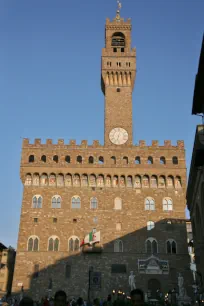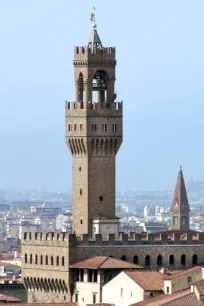The Palazzo Vecchio (Old Palace) is the city hall of Florence. It was built at the start of the 14th century as the Palazzo del Popolo, or Palace of the People. The fortress-like building with crenelated walls is one of the city’s most famous landmarks.



The first stone of the Palazzo Vecchio was laid in 1299 after the people of Florence had decided they needed a new location for their government, one that reflected the city’s growing importance.
Bell Tower
The building was completed twenty-three years later, when a large bell was hoisted into the impressive bell tower. The bell was tolled to announce public meetings or to warn of imminent danger.
The tower, which reaches a height of ninety-four meters (308 ft.) – at the time a very impressive height – is named Torre d’Arnolfo after the Italian architect and sculptor Arnolfo di Cambio, to whom the construction of the palazzo is attributed.
What’s in a name
The palace was originally known as the Palazzo del Popolo (People’s Palace). Later it was renamed Palazzo della Signoria, after the signori, representatives of the important families who ruled over the city. This explains the name of the square bordering the palace, the Piazza della Signoria. After duke Cosimo I was brought to power in 1537, the palace was renamed Palazzo Ducale (Duke’s Palace). When the duke moved to the Palazzo Pitti in 1550, the building became known as the Palazzo Vecchio or Old Palace.
The Palazzo
The stone exterior of the palace hasn’t changed much since the fourteenth century. It has two rows of elegant Gothic windows. Above the windows are painted coats of arms from the Florentine republic. The only part of the exterior that is elaborately decorated is the marble frieze, which was added above the entrance in 1528.
The inscription ‘Rex regum et Dominus Dominantium’ was meant to remind the rulers that Christ was the only ruler. On either side of the inscription is a gilded lion statue.
The interior of the Palazzo Vecchio dates back to the reign of Cosimo I, who had the palace completely redecorated by Giorgio Vasari, the court architect of the Medici. Most of the frescoes in the palace were created by him.
The main inner courtyard was designed in 1453 by Michelozzi Michelozzo. The small fountain at the center is decorated with a statue of a putti and dolphin – a copy by Vasari of a statue created by Verrocchio. The original statue is now in a room on the second floor of the Palazzo Vecchio.

Two monumental stairs lead to the palace’s most impressive room, the Salone dei Cinquecento (Hall of the Five Hundred) on the first floor. The large hall was used for meetings held by the rulers of Florence. In 1503 Piero Soderini requested Leonardo da Vinci and Michelangelo to decorate the hall. Cosimo I later commissioned Giorgio Vasari with the redecoration of the hall, and Vasari worked on the murals from 1563 to 1565. The murals show scenes that depict Cosimo I’s victories over Pisa and Siena and the creation of the grand duchy of Tuscany.
In March 2012 scientists believed they found evidence that in 1505 Leonardo da Vinci did actually paint a mural in the Hall of the Five Hundred, now hidden behind Vasari’s work. Da Vinci’s mural, ‘The Battle of Anghiari’, commemorated the 1440 victory of Florence over Milan on the plain of Anghiari.
Another interesting room in the Palazzo Vecchio is the Sala dei Gigli (Lily room), located on the second floor. The walls are decorated with golden lilies and frescoes of Roman dignitaries.

